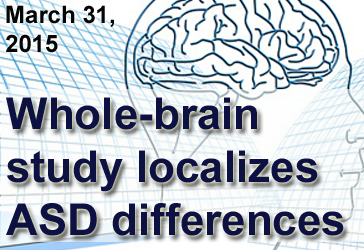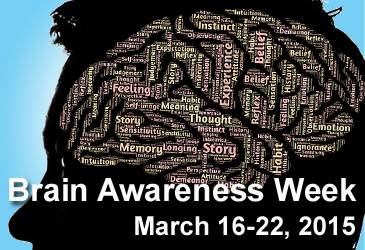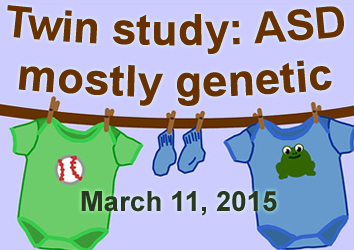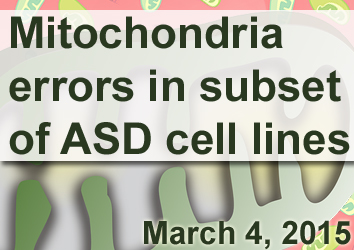Archives
March, 2015
Select a different month in the archive
Study Pinpoints Differences in Autistic Brain
By Chelsea E. Toledo, M.A. on March 31, 2015

Background: Autism Spectrum Disorder (ASD) is characterized by differences in social interaction, communication, and behavior. Researchers have hypothesized that the functioning of—and communication between—related brain regions is atypical in people affected by the disorder. Their studies have largely focused on select areas of the brain, as opposed to observing them within the context of the entire brain system.
What’s new: On March 20, 2015, the journal Brain published a large study providing a whole-brain perspective of ASD versus typical development. The researchers used a grid-based technique to analyze the entire brain at once with data from existing functional Magnetic Resonance Imaging (fMRI) scans of the resting brain. They found that, in comparison to 509 typically developing individuals, the 419 participants with ASD showed differences in 20 key areas.
Why it’s important: The observed differences were in areas of the brain active in processing facial expressions, sense of self, and theory of mind—the ability to discern and predict other’s mental states. Future studies could leverage this technique to learn more about brain function in obsessive compulsive disorder, attention deficit hyperactive disorder, and schizophrenia.
Help me understand :
| Source(s) : |
| Tweet |
Brain Awareness Week 2015
By Shana R. Spindler, Ph.D. on March 16, 2015

March 16-22 marks Brain Awareness Week 2015, a worldwide campaign coordinated by the Dana Alliance for Brain Initiatives and the Society for Neuroscience to promote the progress and benefits of brain research. Hundreds of international events are underway in celebration of this unique week.
Autism Reading Room offers extensive coverage of brain biology, from development to function, in our Brain Biology area. Check it out!
Help me understand :
| Source(s) : |
| Tweet |
Twin Study Finds Autism Risk Is Largely Genetic
By Chelsea E. Toledo, M.A. on March 11, 2015

Background: Autism Spectrum Disorder (ASD) affects about 1 percent children worldwide. Many children who are diagnosed have a sibling with ASD. Research has suggested that the disorder is heritable. While some researchers report that genetic factors are more predictive of ASD, other investigations suggest that environmental factors play an equal, if not larger, role.
What’s new: On March 4, 2015, the journal JAMA Psychiatry published a study of ASD in pairs of twins. The researchers recruited participants of a longitudinal study on identical twins, who share the same DNA, and fraternal twins, who have DNA similarity equivalent to non-twin siblings. After an initial screening of more than 6,000 twin pairs born in the United Kingdom between 1994 and 1996, the researchers conducted additional evaluations for ASD on smaller groups of twin pairs. They found that the identical twins were far more likely to share an ASD diagnosis. They also found that some environmental factors, such as living in an area with high air pollution, increased the risk of an ASD diagnosis—but that those played less of a role than genetic influences.
Why it’s important: Using a large cohort of twin pairs and a variety of diagnostic tools, the researchers have highlighted the genetic underpinning of ASD and ASD-related traits. Furthermore, they showed that the liability to ASD resides mainly in the additive effects of genetic factors. Future studies could probe genetic and environmental factors further—examining the predominance of ASD in boys and exploring possible interactions between genetics and the environment, for instance.
Help me understand :
| Source(s) : |
| Tweet |
ASD Subset More Sensitive to Mitochondrial Stressors
By Shana R. Spindler, Ph.D. on March 4, 2015

Background: Mitochondria, the microscopic powerhouses of cells, provide energy for cellular functions throughout the body and brain. Several studies have linked mitochondrial damage or dysfunction to complex neurological disorders, including autism. Both genetic mutations and environmental insults can disrupt mitochondrial function.
What’s new: On January 21, 2015, the Journal of Toxicology published a study looking at mitochondrial sensitivity to oxidative stress (when the body fails to eliminate damaging free radicals in the cell) in 19 children with autistic disorder (AD) and 19 control individuals. The researchers used a type of blood cell to make cell lines—where cells grow and replicate in a petri dish—for their study. All of the cells derived from AD children had a baseline level of mitochondrial dysfunction compared to controls. The researchers reported a subset of AD children (31 percent) whose cells exhibited remarkably abnormal mitochondrial function when exposed to ethylmercury, a chemical known to cause oxidative stress. The pretreatment of these cells with an antioxidant-boosting drug before ethylmercury exposure improved mitochondrial function.
Why it’s important: Ethylmercury is most famous for its role as a metabolite of thiomerisal, the controversial preservative in some vaccines. The take home message from this study is not that ethylmercury—or a vaccine—causes autism, but that a subset of autistic individuals may be more sensitive to environmental stressors, such as oxidative stress, due to abnormal mitochondria function in cells. The authors of the study are quick to point out that any assumptions made about ethylmercury exposure in the living person based on these in vitro cell results would be “overstating and unsubstantiated.” Why the mitochondria of these individuals is more sensitive, and how that may affect brain function, remains an open question.
Help me understand :
| Source(s) : |
| Tweet |

